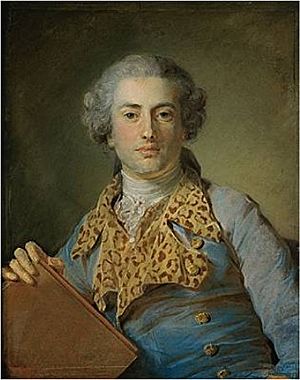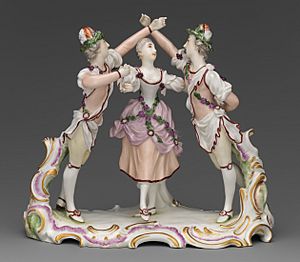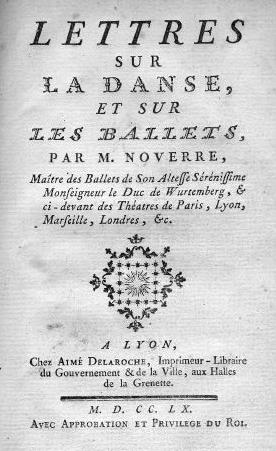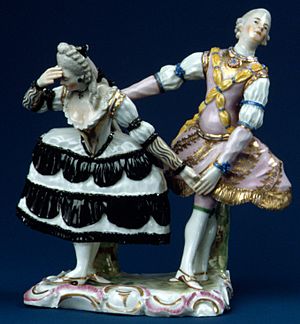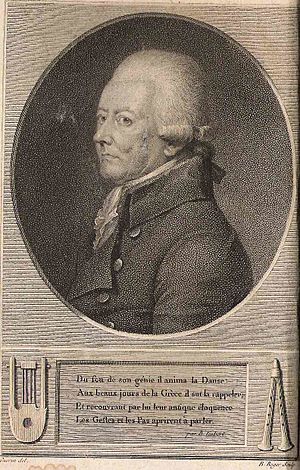Jean-Georges Noverre facts for kids
Jean-Georges Noverre (born April 29, 1727 – died October 19, 1810) was a famous French dancer and balletmaster. He is often called the "father of modern ballet." He created a new style of ballet called ballet d'action. This style told a story through dance and was a big step towards the narrative ballets we see today. His birthday is now celebrated as International Dance Day around the world!
Noverre started dancing professionally when he was young. He performed in Paris at the Opéra-Comique and for important people like Frederick II of Prussia in Berlin. He also danced in Dresden and Strasbourg. In 1747, he moved to Strasbourg, then to Lyon in 1750. In 1751, he created his first major work, Les Fêtes Chinoises, for Marseilles. This show was very popular when it came to Paris in 1754. In 1755, a famous actor named David Garrick invited Noverre to London, where he stayed for two years.
Between 1758 and 1760, Noverre created many ballets in Lyon. He also published his important book, Lettres sur la danse et les ballets (Letters on Dance). This book marked a huge change in ballet. Before Noverre, ballets were mostly about fancy costumes and scenery. Dancers didn't show much emotion. Noverre wanted ballet to tell stories and express feelings through movement. He later worked for Karl Eugen, Duke of Württemberg and then for Austrian Empress Maria Theresa. In 1776, Queen Marie Antoinette asked him to become the ballet master at the Paris Opera. He held this important job until the French Revolution made him poor. He passed away on October 19, 1810, in Saint-Germain-en-Laye.
Noverre had many famous friends, including the writer Voltaire, the composer Wolfgang Amadeus Mozart, and the actor David Garrick. Garrick even called him "the Shakespeare of the dance." Noverre was most proud of his ballets like La Toilette de Vénus and Jason et Médée. Besides his book on dance, he also wrote other books about opera and public celebrations.
Contents
Early Life and Dance Career
Jean-Georges Noverre was born in Paris on April 29, 1727. His father was a Swiss soldier. His parents hoped he would join the military, but Noverre chose to dance instead. He studied with famous teachers like Louis Dupré. Noverre's first professional performance was likely in Paris in 1743.
As a teenager, Noverre danced in many places. He performed at Fontainebleau and in Berlin for King Frederick II of Prussia. He also danced in Dresden and Strasbourg. In 1747, he became a ballet master in Strasbourg. There, he created his first big hit, Les Fêtes Chinoises. In 1748, he married actress Marie-Louise Sauveur in Strasbourg. By 1750, he was a main dancer in Lyon. He created his first ballet-pantomime, Le Jugement de Pâris, in 1751.
Noverre then went to Vienna to work for Queen Maria Theresa of Austria. He became the dance teacher for her 12-year-old daughter, Marie-Antoinette. Noverre and Marie-Antoinette became very close friends. She later became his supporter. In 1754, Noverre created a very dramatic scene that upset the queen, and he lost his job. He moved back to Strasbourg for a year. Then, he returned to the Opéra-Comique in Paris, where Les Fêtes Chinoises was a huge success again in July 1754.
In 1755, Noverre went to London with his family and dance company. He worked with David Garrick at the Theatre Royal, Drury Lane. There, Noverre learned new ideas about theater and natural acting. When his show Les Fêtes Chinoises was ruined by rioters in London, Noverre and his family had to hide. He continued to work on dance shows at Drury Lane without being publicly named.
In 1774, King Louis XV died, and Noverre's friend Marie-Antoinette became the Queen of France. She remembered Noverre and appointed him to the Paris Opera. This was a great moment for him. However, some other dancers and artists turned people against Noverre. He lost his position in 1779 but stayed at the Opera until 1781. Noverre's ideas continued to influence the Paris ballet world. His tragic ballet Jason et Médée was performed in 1763. Later, Pierre Gardel took over the Paris Opera in 1787. He continued to use Noverre's ideas about costumes and pantomime ballet. Noverre believed in natural-looking costumes. For example, he dressed dancers in tiger skins and shoes made of tree bark. This showed his modern thinking during the French Enlightenment.
Letters on Dance and Ballets
Noverre's book about dance and theater shared his ideas on how to create ballets and how to teach dance. He wrote this book in London in 1756 and published it in 1760 in Lyon, France. He did his research at the Drury Lane Theatre in London, where he worked with his own dance group. He was inspired by ancient writings on pantomime. Noverre believed that ballet should tell a story through dramatic movement. The movements should show the feelings between the characters. He called this new type of ballet ballet d’action or pantomime ballet.
From 1757 to 1760, he created 13 new ballets with composer François Granier at the Lyon Opera. His lighter, colorful ballets like Les Caprices de Galathée were very successful.
Who Inspired Noverre?
Noverre was greatly influenced by Jean-Philippe Rameau, David Garrick, and Marie Sallé. Rameau was a very important French composer. Noverre liked his dance music, which had strong, individual parts. David Garrick was an actor and theater director. Noverre was inspired by Garrick's amazing acting and mime work. Noverre wanted to break away from the old, strict forms of ballet.
Marie Sallé also had a huge impact on Noverre. Sallé had studied in Paris with Françoise Prévost, who was known for making ballet more dramatic with her expressive performances. Sallé first performed at the Paris Opera in 1727. She became known for her "delicate grace and expressive mime."
Sallé performed her own pantomime ballets in London in 1733-34. She also worked with the composer George Frideric Handel. Her pantomimes were an early example of what Noverre would later call ballet d'action. When she returned to Paris in 1735, she choreographed and danced in scenes for Jean-Philippe Rameau's opera-ballets. She retired from public performing in 1741. However, she continued to influence dance through her teaching and new ideas at the Opéra-Comique in 1743. This was the same year Noverre made his debut.
Noverre was able to bring his ideas forward because it was a "man's world" back then. Marie Sallé's creative work as a choreographer was not fully recognized during her lifetime. Even today, historians sometimes overlook her role as a pioneer. But Sallé's expressive movements and talents laid the groundwork for Noverre. Her ballet Pygmalion combined expressive gestures and dance to tell its story. Many historians now believe Sallé was the true inventor of ballet d'action.
Sallé also worked to change the strict ballet world before Noverre. She made ballet more artistic by combining dance movement with expressive gestures that matched the music. She also changed costumes and stage scenery in new ways. For example, she stopped wearing masks and changed costumes to be more realistic. Noverre later adopted these ideas in his own book. Sallé's changes to costumes were very bold for her time. Noverre's idea of costume reform clearly came from his connection with her. He is known for getting rid of the dancer's mask. This was likely inspired by Sallé's "noble, expressive and spiritual" face, which he mentioned in his letters.
When we look at how quickly Noverre changed ballet, we must remember all the work Sallé did before him. Given her background and the challenges women faced in the 18th century, Sallé's achievements were incredible. She broke barriers by creating and performing her own dances when women were usually only allowed to interpret men's creations. We cannot fully appreciate Noverre's new ideas without understanding the big changes that came from Sallé's life and work.
What Noverre's Book Said
Noverre's book called for an end to old, strict traditions at the Paris Opéra Ballet. He wanted to get rid of heavy, uncomfortable costumes and old-fashioned music and dance steps. Noverre also talked about how to train dancers. He believed teachers should help students use their own unique talents. Most of Noverre's criticisms were aimed at the Paris Opera Ballet. He felt their ballets were separate from the main story of the opera. He especially disliked the use of masks because they stopped dancers from showing facial expressions. Noverre wrote a whole chapter about masks, saying, "Destroy the masks, and we shall gain a soul, and be the best dancers in the world."
Noverre focused on seven main points in his book:
- He said that dancers' training should be correct, but also consider each dancer's body.
- He believed that understanding a dancer's personality was key to their artistic growth.
- Noverre stressed that in a ballet, gestures must be true and sincere to tell the story.
- He wanted ballet plots to develop logically. All extra solos and unnecessary dance moves should be removed.
- Noverre insisted that the music should always fit the story of the ballet.
- He said that costumes, scenery, and lighting should match the story and mood of each part of the ballet.
- With masks gone from his ballets, Noverre shared his ideas on stage make-up. This allowed the dancer's expressions to be seen, not hidden.
How Noverre's Ideas Changed Ballet
Noverre's book, Les Lettres sur la danse et sur les ballets, had a lasting impact on ballet. It has been printed in many languages, and his name is often mentioned in dance history. Many of his ideas are still used in dance classes today. For example, his idea that teachers should help students use their own talents, rather than just copy others, is still a common belief in dance. While Noverre faced criticism from other ballet artists, his ideas have lasted much longer than his actual ballets, which haven't been performed for at least 200 years.
Major Works
- Les Fêtes Chinoises (Paris 1754)
- La Fontaine de jouvence (Paris 1754)
- La Toilette de Vénus (Lyon 1757)
- L'Impromptu du sentiment (Lyon 1758)
- La Mort d'Ajax (Lyon 1758)
- Alceste (Stuttgart 1761)
- La Mort d'Hercule (Stuttgart 1762)
- Psyché et l'Amour (Stuttgart 1762)
- Jason et Médée (Stuttgart 1763)
- Hypermnestre (Stuttgart 1764)
- Diane et Endymion (Vienna 1770)
- Don Chisciotte, alle nozze di Gamace (Vienna 1772)
- Le Judgement de Pâris (Vienna 1771)
- Roger et Bradamante (Vienna 1771)
- Agamemnon vengé (Vienna 1772)
- Iphigénie en Tauride (Vienna 1772)
- Thésée (Vienna 1772)
- Acis et Galathée (Vienna 1773)
- Adèle de Ponthieu (Vienna 1773)
- Alexandre et Campaspe de Larisse (Vienna 1773)
- Les Horaces et les Curiaces (Vienna 1774)
- Renaud et Armide (Milan 1775)
- Apelle et Campaspe (Paris 1776)
- Les Caprices de Galatée (Paris 1776)
- Annette et Lubin (Paris 1778)
- Les petits riens (Paris 1778)
- Les Amours d'Énée et de Didon (Lyon 1781)
- La Fête du Sérail (Paris 1788)
- L'Amour et Psyché (London 1788)
- La Fête de Tempé (London 1788)
- Admète (London 1789)
- La Bergère des Alpes (London 1794)
- La Vittoria (London 1794)
- Windsor Castle (London 1795)
See also
 In Spanish: Jean-Georges Noverre para niños
In Spanish: Jean-Georges Noverre para niños
- Eugène Hus


